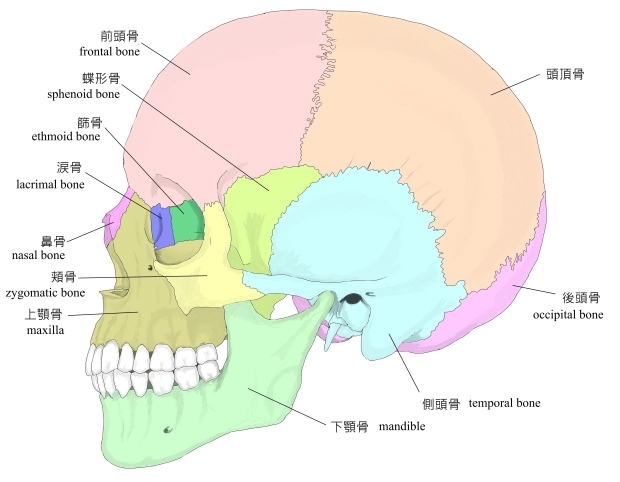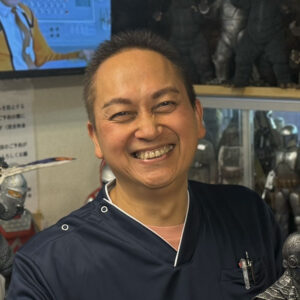At my salon, I primarily focus on cranial bone adjustments, and I also incorporate carbonated mist in combination with muscle and joint adjustments during my treatments.
Many people are surprised when they first hear the term “cranial adjustment.”
The word for skull in Japanese is commonly read as “zugai” but in anatomy, it is read as “tōgai.” (Note: The English term is consistently “skull” or “cranium” regardless of reading.)
It is generally believed that the skull is made up of a single bone.
However, it is actually composed of 23 bones that are joined together to form one cranium, and these bones move rhythmically with every breath you take.

Due to this movement with each breath, the joints (sutures) of the skull can shift or the overall structure can become distorted.
When these misalignments and poor movement increase, they can potentially lead to various problems throughout the entire body.
The skull contains corresponding points for every bone and joint in the body.
It’s almost as if the skull holds a map of the entire body.
Adjusting the skull can improve ankle movement, relieve knee pain, eliminate back discomfort, resolve stiff shoulders, and even change the alignment and position of the pelvis.
In short, it means we can adjust the entire body through the skull.
That’s amazing, isn’t it?!
Conversely, it is also possible to change the position of the skull by adjusting the hands and feet.
Simultaneously, facial distortion can also be considered body distortion.
Is Cranial Adjustment Painful?
My treatment is gentle and low-impact, involving light touching or stroking, rather than aggressive, non-standard procedures like forcefully pushing on the face.
Most clients feel so relaxed during the session that they doze off or even snore.
Issues Caused by Cranial and Facial Distortion
① The face appears wider horizontally
When a part of the skull is misaligned, the temporal bones on the sides of the face can flare outward, making the face feel and appear larger.
It is not uncommon for some people to have an outward protrusion of 1 cm or more.
② Facial wrinkles, sagging, and dark circles
Skull misalignment can affect the teeth’s bite (occlusion), causing distortion in the face and jaw.
Furthermore, poor lymph and blood circulation above the neck can lead to wrinkles, sagging, and dark circles around the eyes.
③ Neck wrinkles and sagging
Distortion or compression of the cervical vertebrae (neck bones) puts a strain on the intervertebral discs.
This can make the neck appear shorter, sometimes resulting in wrinkles and sagging around the neck area.
④ Nasolabial folds (smile lines) and double chin
When the skull is distorted, the muscles attached to the jaw and cheeks become unbalanced.
This can cause the cheeks to sag, leading to one nasolabial fold (next to the nose and mouth corners) appearing more prominent or darker than the other.
Additionally, an imbalance in the muscles under the jaw can contribute to a double chin.
⑤ Shallow breathing
Pressure in the back of the nose, or restricted movement in the ribs and back, can lead to shallow breathing.
What does “shallow breathing” mean?
It puts the human body in a constant state of stress. Cranial adjustment can ease breathing and free the body from this distress.
⑥ Flat feet, foot pain, and discomfort
Misalignment in a specific part of the skull can affect the legs (feet), potentially leading to flat feet or knee pain.
⑦ Irritability and subjective symptoms (Futeishūso)
Skull misalignment can cause hormonal imbalances and even insomnia.
This, in turn, can lead to inexplicable irritability and lashing out at others.
It is important not to let your physical discomfort damage your relationships.
Nearly 100% of clients diagnosed with menopausal syndrome also have a rigid skull.
I can also help alleviate the symptoms of menopause.
⑧ Lower back pain, stiff shoulders, knee pain, and even bow legs?
As mentioned, skull distortion affects the entire body, and quite significantly so.
If you have never had your skull adjusted in previous bodywork sessions, you could say the treatment was incomplete.
I recommend cranial adjustment for those experiencing the symptoms listed above.
Relationship with Temporomandibular Joint Disorder (TMJ/TMD)

An surprisingly large number of people suffer from symptoms related to TMJ disorders.
When experiencing jaw pain, it is easy to focus only on the temporomandibular joint, but the pain is actually a result of overall body distortion.
The influence of skull distortion is particularly significant.
・Causes include but are not limited to:
・Mental stress
・Recent or current dental treatment
・Current or previous orthodonic treatment(braces)
・Dental inplants
・A history of severe ankle spains
・A hustory of accute lower back pain(lumbago)
I will work with you through a detailed consultation to investigate the cause and aim for improvement.
Furthermore, neglecting jaw distortion can lead to facial asymmetry.
Many people notice facial asymmetry when looking at their own photos.
If TMJ disorder is left untreated, it can impair the function of the autonomic nervous system, leading to headaches, irritability, tinnitus (ringing in the ears), insomnia, sleep apnea, and unique issues for women such as menstrual pain and irregular periods.
Before these complications arise, I recommend a total cranial adjustment that includes the adjustment of the temporomandibular joint.


